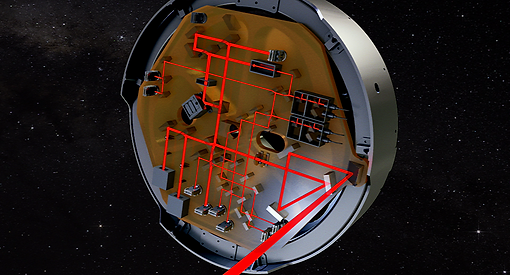by Group 7
Interferometry
Interferometry is a technique in which waves are superimposed to cause the phenomenon of interference, which is used to extract information. Interferometry typically uses electromagnetic waves and is an important investigative technique in the fields of astronomy, fiber optics, engineering metrology, optical metrology, oceanography, seismology, spectroscopy (and its applications to chemistry), quantum mechanics, nuclear and particle physics, plasma physics, remote sensing, biomolecular interactions, surface profiling, microfluidics, mechanical stress/strain measurement, velocimetry, optometry, and making holograms.

Interferometers are devices that extract information from interference. They are widely used in science and industry for the measurement of small displacements, refractive index changes and surface irregularities. In most interferometers, light from a single source is split into two beams that travel in different optical paths, which are then combined again to produce interference; however, under some circumstances, two incoherent sources can also be made to interfere.
Interferometry makes use of the principle of superposition to combine waves in a way that will cause the result of their combination to have some meaningful property that is diagnostic of the original state of the waves. This works because when two waves with the same frequency combine, the resulting intensity pattern is determined by the phase difference between the two waves

Typically a single incoming beam of coherent light will be split into two identical beams by a beam splitter (a partially reflecting mirror). Each of these beams travels a different route, called a path, and they are recombined before arriving at a detector. The path difference, the difference in the distance travelled by each beam, creates a phase difference between them. It is this introduced phase difference that creates the interference pattern between the initially identical waves. If a single beam has been split along two paths, then the phase difference is diagnostic of anything that changes the phase along the paths. This could be a physical change in the path length itself or a change in the refractive index along the path.
Interferometry in LISA
Within LISA, there is its payload which consists of two identical units on each spacecraft. Each unit contains a Gravitational Reference Sensor and a telescope that transmits the laser light. And so the laser interferometry is performed on an optical bench in between the telescope and the GRS. LISA’s interferometer has it pros and cons but a unique feature of LISA interferometry is the virtual elimination of the effects of laser frequency noise, which would otherwise couple to the science signal through the sizable arm length difference.


Michelson-Morley Experiment
The Michelson–Morley experiment was an attempt to detect the existence of the luminiferous aether, a supposed medium permeating space that was thought to be the carrier of light waves. It was the first Interferometry scientific activity documented. The experiment was performed between April and July 1887 by American physicists Albert A. Michelson and Edward W. Morley.
The experiment and the theory behind it was concluded false after Einstein theories were published.

Homemade Interferometer
We decided to do a ”Homemade Interferometer” we used the normal display of a Interferometer but with the materials we had in hand, the Interferometer is composed of a Low Powered Laser, a Lens that acted as the beam splitter, 2 Mirrors, and one Last Lens that acted as the receiver, computer/photodetector.
Every part on this Interferometer was provided by the school teacher.